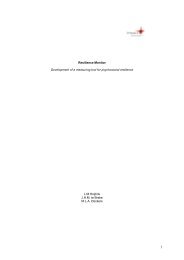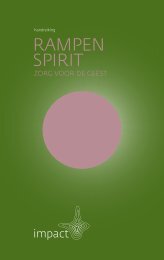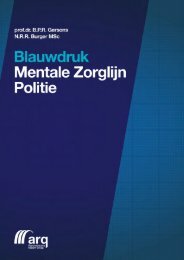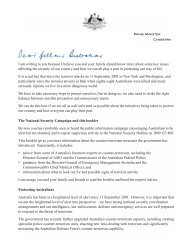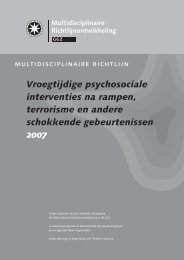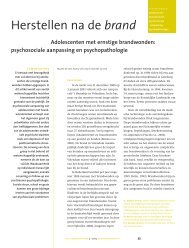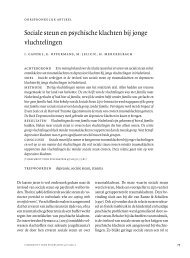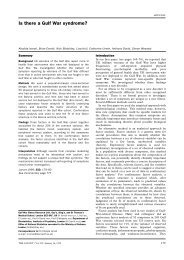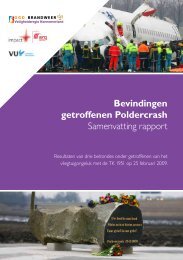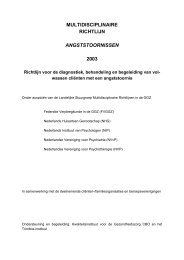The effect of a severe disaster on the mental health ... - ResearchGate
The effect of a severe disaster on the mental health ... - ResearchGate
The effect of a severe disaster on the mental health ... - ResearchGate
You also want an ePaper? Increase the reach of your titles
YUMPU automatically turns print PDFs into web optimized ePapers that Google loves.
ARTICLES<br />
<str<strong>on</strong>g>The</str<strong>on</strong>g> <str<strong>on</strong>g>effect</str<strong>on</strong>g> <str<strong>on</strong>g>of</str<strong>on</strong>g> a <str<strong>on</strong>g>severe</str<strong>on</strong>g> <str<strong>on</strong>g>disaster</str<strong>on</strong>g> <strong>on</strong> <strong>the</strong> <strong>mental</strong> <strong>health</strong> <str<strong>on</strong>g>of</str<strong>on</strong>g><br />
adolescents: a c<strong>on</strong>trolled study<br />
Sijmen A Reijneveld, Mathilde R Cr<strong>on</strong>e, Frank C Verhulst, S Pauline Verloove-Vanhorick<br />
Summary<br />
Background Disasters greatly affect <strong>the</strong> <strong>mental</strong> <strong>health</strong> <str<strong>on</strong>g>of</str<strong>on</strong>g><br />
children and adolescents, but quantificati<strong>on</strong> <str<strong>on</strong>g>of</str<strong>on</strong>g> such <str<strong>on</strong>g>effect</str<strong>on</strong>g>s<br />
is difficult. Using prospective pre<str<strong>on</strong>g>disaster</str<strong>on</strong>g> and post<str<strong>on</strong>g>disaster</str<strong>on</strong>g><br />
data for affected and c<strong>on</strong>trol populati<strong>on</strong>s, we aimed to<br />
assess <strong>the</strong> <str<strong>on</strong>g>effect</str<strong>on</strong>g>s <str<strong>on</strong>g>of</str<strong>on</strong>g> a <str<strong>on</strong>g>severe</str<strong>on</strong>g> <str<strong>on</strong>g>disaster</str<strong>on</strong>g> <strong>on</strong> <strong>the</strong> <strong>mental</strong> <strong>health</strong><br />
and substance use <str<strong>on</strong>g>of</str<strong>on</strong>g> adolescents.<br />
Methods In January, 2001, a fire in a café in Volendam,<br />
Ne<strong>the</strong>rlands, wounded 250 adolescents and killed 14. In <strong>the</strong><br />
15 m<strong>on</strong>ths before <strong>the</strong> <str<strong>on</strong>g>disaster</str<strong>on</strong>g>, all grade 2 students (aged<br />
12–15 years) from a school in Volendam (<str<strong>on</strong>g>of</str<strong>on</strong>g> whom 31 were<br />
in <strong>the</strong> café during <strong>the</strong> fire), and from two o<strong>the</strong>r schools, had<br />
been selected as c<strong>on</strong>trols for a study. 124 Volendam<br />
students and 830 from <strong>the</strong> o<strong>the</strong>r two schools had provided<br />
data for substance use, and completed <strong>the</strong> youth self-report<br />
(YSR) questi<strong>on</strong>naire about behavioural and emoti<strong>on</strong>al<br />
problems. 5 m<strong>on</strong>ths after <strong>the</strong> <str<strong>on</strong>g>disaster</str<strong>on</strong>g>, we obtained follow-up<br />
data from 91 (resp<strong>on</strong>se rate 73·4%) Volendam adolescents<br />
and 643 (77·5%) c<strong>on</strong>trols from <strong>the</strong> o<strong>the</strong>r two schools. <str<strong>on</strong>g>The</str<strong>on</strong>g><br />
primary outcome measures were changes in score in YSR<br />
categories <str<strong>on</strong>g>of</str<strong>on</strong>g> total problems, alcohol misuse, smoking, and<br />
substance use. We compared changes in scores between<br />
groups using logistic regressi<strong>on</strong>.<br />
Findings Volendam adolescents had larger increases in<br />
clinical scores than c<strong>on</strong>trols for total problems (odds ratio<br />
1·82, 95% CI 1·01–3·29, p=0·045) and excessive use <str<strong>on</strong>g>of</str<strong>on</strong>g><br />
alcohol (4·57, 2·73–7·64, p
ARTICLES<br />
124 at affected<br />
school<br />
33 lost to follow-up<br />
5 present at fire<br />
(not wounded but<br />
did not fill in<br />
follow-up<br />
questi<strong>on</strong>naire)<br />
11 wounded by fire<br />
and could not be<br />
c<strong>on</strong>tacted<br />
1 died because<br />
<str<strong>on</strong>g>of</str<strong>on</strong>g> fire<br />
16 o<strong>the</strong>r reas<strong>on</strong>s<br />
91 completed<br />
follow-up<br />
954 adolescents<br />
with complete<br />
baseline data<br />
830 at c<strong>on</strong>trol<br />
schools<br />
187 lost to<br />
follow-up<br />
91 analysed 643 analysed<br />
Participant flow and follow-up<br />
643 completed<br />
follow-up<br />
analysed our observati<strong>on</strong>al data in accord with CONSORT<br />
criteria for <strong>the</strong> analysis <str<strong>on</strong>g>of</str<strong>on</strong>g> randomised c<strong>on</strong>trolled trials, 16 to<br />
best obtain informati<strong>on</strong> from this study.<br />
Methods<br />
Participants<br />
In <strong>the</strong> affected school, 124 students aged 12–15 years<br />
(mean 13·6) had completed <strong>the</strong> baseline questi<strong>on</strong>naire. Of<br />
<strong>the</strong>se, 31 were at <strong>the</strong> fire, 17 <str<strong>on</strong>g>of</str<strong>on</strong>g> whom were wounded. <str<strong>on</strong>g>The</str<strong>on</strong>g><br />
o<strong>the</strong>r two schools were unaffected by <str<strong>on</strong>g>disaster</str<strong>on</strong>g>s and both<br />
were located in <strong>the</strong> middle <str<strong>on</strong>g>of</str<strong>on</strong>g> <strong>the</strong> Ne<strong>the</strong>rlands, about<br />
80 km from <strong>the</strong> affected school. 830 students aged<br />
12–15 years (mean 13·8) had completed <strong>the</strong> baseline<br />
questi<strong>on</strong>naire. <str<strong>on</strong>g>The</str<strong>on</strong>g>se students are c<strong>on</strong>trols in this study.<br />
At baseline, all adolescents were informed about <strong>the</strong><br />
nature <str<strong>on</strong>g>of</str<strong>on</strong>g> <strong>the</strong> original study, and that a sec<strong>on</strong>d<br />
measurement would be taken.<br />
<str<strong>on</strong>g>The</str<strong>on</strong>g> original study protocol had been approved by <strong>the</strong><br />
medical ethics committee <str<strong>on</strong>g>of</str<strong>on</strong>g> TNO Preventi<strong>on</strong> and Health,<br />
Leiden, and included c<strong>on</strong>sent from <strong>the</strong> parents’ council <str<strong>on</strong>g>of</str<strong>on</strong>g><br />
every school. We informed <strong>the</strong> committee about <strong>the</strong> fire.<br />
After discussing <strong>the</strong> situati<strong>on</strong> with <strong>the</strong> headmaster <str<strong>on</strong>g>of</str<strong>on</strong>g> <strong>the</strong><br />
affected school, we c<strong>on</strong>tinued <strong>the</strong> study with <strong>the</strong> inclusi<strong>on</strong><br />
<str<strong>on</strong>g>of</str<strong>on</strong>g> additi<strong>on</strong>al questi<strong>on</strong>s about satisfacti<strong>on</strong> with schoolbased<br />
care after <strong>the</strong> <str<strong>on</strong>g>disaster</str<strong>on</strong>g> and whe<strong>the</strong>r students’ needs<br />
had been met. Results were reported to <strong>the</strong> school<br />
management immediately after follow-up, to assist in<br />
fur<strong>the</strong>r post-<str<strong>on</strong>g>disaster</str<strong>on</strong>g> school planning.<br />
Procedures<br />
In September–October, 1999, students had completed a<br />
baseline questi<strong>on</strong>naire c<strong>on</strong>sisting <str<strong>on</strong>g>of</str<strong>on</strong>g> <strong>the</strong> youth self-report<br />
questi<strong>on</strong>naire (YSR), 17,18 questi<strong>on</strong>s about smoking, 19 and<br />
use <str<strong>on</strong>g>of</str<strong>on</strong>g> alcohol, marijuana, sedatives and hypnotics, and<br />
MDMA (ecstasy). YSR scores, smoking, and use <str<strong>on</strong>g>of</str<strong>on</strong>g><br />
alcohol were <strong>the</strong> primary endpoints <str<strong>on</strong>g>of</str<strong>on</strong>g> <strong>the</strong> original study,<br />
and remained so in <strong>the</strong> post<str<strong>on</strong>g>disaster</str<strong>on</strong>g> analyses. <str<strong>on</strong>g>The</str<strong>on</strong>g> YSR<br />
was used to assess <strong>the</strong> adolescent’s report <str<strong>on</strong>g>of</str<strong>on</strong>g> <strong>the</strong>ir<br />
behavioural and emoti<strong>on</strong>al problems in <strong>the</strong> preceding 6<br />
m<strong>on</strong>ths. Its reliability and validity have been replicated for<br />
<strong>the</strong> Dutch translati<strong>on</strong> from English. 17,18 We also obtained<br />
data for sex, age, level <str<strong>on</strong>g>of</str<strong>on</strong>g> educati<strong>on</strong> (lower or higher—ie,<br />
junior sec<strong>on</strong>dary vocati<strong>on</strong>al educati<strong>on</strong> or general<br />
sec<strong>on</strong>dary educati<strong>on</strong> US higher), ethnic background (<str<strong>on</strong>g>of</str<strong>on</strong>g><br />
child and both parents—at least two born in <strong>the</strong><br />
Ne<strong>the</strong>rlands, or o<strong>the</strong>r), religi<strong>on</strong> (Christian, o<strong>the</strong>r, or<br />
n<strong>on</strong>e), and parental employment (<strong>on</strong>e or both parents<br />
working more than 3 days per week, or o<strong>the</strong>r).<br />
As planned, all students completed <strong>the</strong> same<br />
questi<strong>on</strong>naire in May, 2001. To ensure comparability <str<strong>on</strong>g>of</str<strong>on</strong>g><br />
informati<strong>on</strong>, we took no measures to increase <strong>the</strong> resp<strong>on</strong>se<br />
<str<strong>on</strong>g>of</str<strong>on</strong>g> Volendam adolescents. We added some questi<strong>on</strong>s to <strong>the</strong><br />
end <str<strong>on</strong>g>of</str<strong>on</strong>g> <strong>the</strong> Volendam students’ questi<strong>on</strong>naires regarding<br />
<strong>the</strong>ir exposure to <strong>the</strong> fire, and school-based post<str<strong>on</strong>g>disaster</str<strong>on</strong>g><br />
care. Data for fire exposure <str<strong>on</strong>g>of</str<strong>on</strong>g> those lost to follow-up were<br />
provided by <strong>the</strong> school management. Resp<strong>on</strong>ses were<br />
an<strong>on</strong>ymous and could <strong>on</strong>ly be linked by school code, sex,<br />
date <str<strong>on</strong>g>of</str<strong>on</strong>g> birth, and initials <str<strong>on</strong>g>of</str<strong>on</strong>g> <strong>the</strong> adolescent.<br />
For <strong>the</strong> analyses, we dichotomised all outcome<br />
measures, using cut-<str<strong>on</strong>g>of</str<strong>on</strong>g>fs as planned in <strong>the</strong> original study.<br />
Of <strong>the</strong> YSR, we used <strong>on</strong>ly <strong>the</strong> items relating to <strong>mental</strong><br />
<strong>health</strong> problems and calculated scores for nine symptom<br />
subscales, two broad groups <str<strong>on</strong>g>of</str<strong>on</strong>g> symptoms designated<br />
internalising and externalising (each comprising several<br />
symptom subscales <str<strong>on</strong>g>of</str<strong>on</strong>g> emoti<strong>on</strong>al and behavioural<br />
problems, respectively), and a total problems score.<br />
Adolescents were allocated to a normal or clinical range,<br />
with <strong>the</strong> 98th percentile <str<strong>on</strong>g>of</str<strong>on</strong>g> <strong>the</strong> Dutch normative sample as<br />
cut-<str<strong>on</strong>g>of</str<strong>on</strong>g>f for symptom subscales, and <strong>the</strong> 90th percentile for<br />
o<strong>the</strong>r scales. 18 Smoking was defined as at least <strong>on</strong>e cigarette<br />
Analysed group Lost to follow-up p†<br />
Affected (n=91) C<strong>on</strong>trol (n=643) p* Affected (n=33) C<strong>on</strong>trol (n=187) p*<br />
Girls 57 (62·6%) 314 (48·8%) 0·014 21 (63·6%) 88 (47·1%) 0·08 0·80<br />
Mean (95% CI) age 13·59 (13·52–13·67) 13·75 (13·71–13·79) 0·004 13·75 (13·60–13·91) 13·86 (13·78–13·94) 0·29 0·004<br />
Aged 14 years and older 11 (12·1%) 169 (26·3%) 0·003 9 (27·3%) 65 (34·8%) 0·40 0·007<br />
In low-level educati<strong>on</strong> 34 (37·4%) 343 (53·5%) 0·004 13 (39·4%) 103 (55·4%) 0·09 0·70<br />
N<strong>on</strong>-Dutch ethnic background 0 (0·0%) 58 (9·1%) 0·003 3 (9·7%) 19 (10·4%) 1·00 0·29<br />
Christian religi<strong>on</strong> 63 (70·8%) 162 (26·0%)
ARTICLES<br />
Affected school C<strong>on</strong>trol schools Difference in change between groups Intenti<strong>on</strong> to treat (affected school<br />
(n=81)* (n=633)* n=124; c<strong>on</strong>trol schools n=830)<br />
Before After Before After Odds ratio Adjusted odds Odds ratio Adjusted odds<br />
(95% CI) ratio (95% CI)† (95% CI) ratio (95% CI)†<br />
Clinical score<br />
Total problems 9 (11·1%) 19 (23·5%) 70 (11·1%) 96 (15·2%) 1·82 (1·01–3·29) 1·67 (0·88–3·20) 1·49 (0·85–2·60) 1·28 (0·70–2·36)<br />
Internalising problems 5 (6·2%) 15 (18·5%) 59 (9·3%) 84 (13·3%) 1·71 (0·91–3·22) 1·70 (0·85–3·37) 1·46 (0·80–2·65) 1·31 (0·69–2·49)<br />
Externalising problems 8 (9·9%) 15 (18·5%) 54 (8·5%) 87 (13·7%) 1·41 (0·76–2·64) 1·62 (0·82–3·22) 1·09 (0·59–1·99) 1·16 (0·61–2·23)<br />
Withdrawn 2 (2·5%) 6 (7·4%) 15 (2·4%) 37 (5·8%) 1·30 (0·52–3·27) 1·40 (0·52–3·77) 0·99 (0·39–2·53) 0·97 (0·36–2·59)<br />
Somatic complaints 5 (6·2%) 7 (8·6%) 34 (5·4%) 40 (6·3%) 1·39 (0·59–3·24) 1·64 (0·65–4·12) 1·32 (0·63–2·79) 1·45 (0·65–3·26)<br />
Anxious or depressed 0 (0·0%) 8 (9·9%) 11 (1·7%) 27 (4·3%) 2·85 (1·23–6·61) 3·20 (1·26–8·09) 2·35 (1·03–5·37) 2·28 (0·93–5·58)<br />
Social problems 3 (3·7%) 4 (4·9%) 34 (5·4%) 24 (3·8%) 1·41 (0·47–4·22) 1·56 (0·47–5·17) 1·27 (0·48–3·37) 1·07 (0·38–3·04)<br />
Thought problems 6 (7·4%) 13 (16·0%) 51 (8·1%) 56 (8·8%) 2·16 (1·09–4·30) 2·54 (1·19–5·44) 1·78 (0·92–3·44) 2·06 (1·01–4·19)<br />
Attenti<strong>on</strong> problems 3 (3·7%) 9 (11·1%) 16 (2·5%) 40 (6·3%) 1·81 (0·82–3·99) 1·96 (0·82–4·66) 1·45 (0·67–3·16) 1·52 (0·65–3·54)<br />
Delinquent behaviour 0 (0·0%) 7 (8·6%) 16 (2·5%) 51 (8·1%) 1·20 (0·52–2·76) 1·74 (0·70–4·29) 1·01 (0·44–2·27) 1·27 (0·53–3·02)<br />
Aggressive behaviour 1 (1·2%) 7 (8·6%) 17 (2·7%) 22 (3·5%) 3·30 (1·30–8·36) 3·71 (1·28–10·7) 2·78 (1·12–6·92) 2·76 (1·00–7·61)<br />
Self destructive or 1 (3·1%) 2 (6·3%) 9 (2·8%) 18 (5·6%) 1·10 (0·24–5·13) 2·07 (0·37–11·7) 0·93 (0·20–4·39) 1·38 (0·27–7·11)<br />
identity problems‡<br />
*In both groups, ten adolescents provided incomplete YSR data at <strong>the</strong> sec<strong>on</strong>d measurement—before refers to those with complete YSR data both before and after <strong>the</strong><br />
<str<strong>on</strong>g>disaster</str<strong>on</strong>g> and <strong>the</strong>refore slightly differ from those in table 1. †Adjusted for sex, age, level <str<strong>on</strong>g>of</str<strong>on</strong>g> educati<strong>on</strong>, ethnic background, and religi<strong>on</strong>. ‡This score can <strong>on</strong>ly be<br />
calculated for boys; number <str<strong>on</strong>g>of</str<strong>on</strong>g> adolescents in analysed group are 32 and 319, for affected school and c<strong>on</strong>trol schools, respectively; for intenti<strong>on</strong>-to-treat analyses,<br />
46 and 428, respectively.<br />
Table 2: Outcomes for behavioural and emoti<strong>on</strong>al problems reported <strong>on</strong> <strong>the</strong> YSR<br />
per m<strong>on</strong>th, excessive use <str<strong>on</strong>g>of</str<strong>on</strong>g> alcohol as at least five drinks<br />
<strong>on</strong> <strong>on</strong>e occasi<strong>on</strong> in <strong>the</strong> preceding 2 weeks, and use <str<strong>on</strong>g>of</str<strong>on</strong>g> o<strong>the</strong>r<br />
psychoactive substances as use at least <strong>on</strong>ce ever.<br />
Statistical analysis<br />
Because <str<strong>on</strong>g>of</str<strong>on</strong>g> <strong>the</strong> nature <str<strong>on</strong>g>of</str<strong>on</strong>g> <strong>the</strong> study, we did not calculate<br />
power beforehand. We compared <strong>the</strong> adolescents <str<strong>on</strong>g>of</str<strong>on</strong>g> <strong>the</strong><br />
affected school who provided follow-up data with those in<br />
c<strong>on</strong>trol schools to look for changes between baseline and<br />
follow-up in all categories, using logistic regressi<strong>on</strong>. Next,<br />
we assessed whe<strong>the</strong>r <strong>the</strong> size <str<strong>on</strong>g>of</str<strong>on</strong>g> <strong>the</strong> changes was affected<br />
by sex or exposure to <strong>the</strong> <str<strong>on</strong>g>disaster</str<strong>on</strong>g>. 2–5 We repeated all<br />
analyses, adjusting for background characteristics that<br />
were significantly different between affected and c<strong>on</strong>trol<br />
schools (age, educati<strong>on</strong>al level, ethnic origin, religi<strong>on</strong>, and<br />
parental employment). We also did an intenti<strong>on</strong>-to-treat<br />
analysis <str<strong>on</strong>g>of</str<strong>on</strong>g> data from all individuals, including those lost<br />
to follow-up. We assumed no change in those lost to<br />
follow-up since baseline. All p values are two-sided and<br />
have not been adjusted for multiple comparis<strong>on</strong>s. We<br />
used 2 tests for all proporti<strong>on</strong>s except for when <strong>the</strong><br />
expected counts were less than 5, in which case we used<br />
Fisher’s exact test. For c<strong>on</strong>tinuous data we used t tests,<br />
and F tests in ANOVA.<br />
Role <str<strong>on</strong>g>of</str<strong>on</strong>g> funding source<br />
<str<strong>on</strong>g>The</str<strong>on</strong>g> sp<strong>on</strong>sors <str<strong>on</strong>g>of</str<strong>on</strong>g> <strong>the</strong> study had no role in study design,<br />
data collecti<strong>on</strong>, data analysis, data interpretati<strong>on</strong>, writing<br />
<str<strong>on</strong>g>of</str<strong>on</strong>g> <strong>the</strong> report, or <strong>the</strong> decisi<strong>on</strong> to submit this report for<br />
publicati<strong>on</strong>.<br />
Results<br />
We received complete data for <strong>the</strong> baseline measurement<br />
from 954 adolescents, <str<strong>on</strong>g>of</str<strong>on</strong>g> whom 124 attended <strong>the</strong> affected<br />
school. Of <strong>the</strong>se, 734 (77%) provided us with at least some<br />
follow-up data, with slightly fewer from <strong>the</strong> affected school<br />
(91 [73·4%]) than from <strong>the</strong> o<strong>the</strong>rs (643 [77·5%], p=0·31).<br />
<str<strong>on</strong>g>The</str<strong>on</strong>g> figure shows participant flow and follow-up. Table 1<br />
shows baseline characteristics <str<strong>on</strong>g>of</str<strong>on</strong>g> all adolescents.<br />
Demographic characteristics but not baseline values <str<strong>on</strong>g>of</str<strong>on</strong>g><br />
outcome measures differed significantly between <strong>the</strong><br />
affected school and c<strong>on</strong>trol schools. Demographic<br />
differences were mostly due to real differences between <strong>the</strong><br />
schools; eg, <strong>the</strong> affected school and <strong>on</strong>e <str<strong>on</strong>g>of</str<strong>on</strong>g> <strong>the</strong> c<strong>on</strong>trol<br />
schools were denominati<strong>on</strong>al—Roman Catholic and<br />
Protestant, respectively. We also analysed whe<strong>the</strong>r affected<br />
and c<strong>on</strong>trol schools differed in loss to follow-up for<br />
characteristics that showed significant overall differences in<br />
loss to follow-up. We did this by assessing <strong>the</strong> interacti<strong>on</strong><br />
between school (affected or c<strong>on</strong>trol) and follow-up status<br />
(analysed or lost to follow-up). N<strong>on</strong>e <str<strong>on</strong>g>of</str<strong>on</strong>g> <strong>the</strong>se interacti<strong>on</strong>s<br />
were significant (range <str<strong>on</strong>g>of</str<strong>on</strong>g> p values: 0·08–0·95). Differences<br />
were thus not due to selective loss to follow-up, since loss to<br />
follow-up by characteristic did not differ between <strong>the</strong><br />
affected school and c<strong>on</strong>trol schools. <str<strong>on</strong>g>The</str<strong>on</strong>g> exposure to <strong>the</strong> fire<br />
was, however, much higher in <strong>the</strong> group lost to follow-up<br />
than in <strong>the</strong> analysed group. In <strong>the</strong> analysed group (n=91),<br />
14 adolescents (15%) were present at <strong>the</strong> fire, <str<strong>on</strong>g>of</str<strong>on</strong>g> whom five<br />
(5%) were wounded; in <strong>the</strong> lost to follow-up group (n=33),<br />
<strong>the</strong>se figures were 17 (52%) and 12 (36%), respectively<br />
(both p
ARTICLES<br />
Boys* Girls* p‡<br />
Odds ratio p Adjusted odds ratio p Odds ratio p Adjusted odds ratio p<br />
(95% CI) (95% CI)† (95% CI) (95% CI)†<br />
Clinical score<br />
Total problems 1·01 (0·28–3·67) 0·99 1·09 (0·27–4·37) 0·91 2·15 (1·07–4·31) 0·031 1·99 (0·95–4·18) 0·07 0·23<br />
Anxious or depressed 0·74 (0·09–5·84) 0·78 1·17 (0·13–11·0) 0·89 5·02 (1·81–13·9) 0·002 5·03 (1·65–15·4) 0·005 0·09<br />
Thought problems 1·79 (0·57–5·63) 0·32 2·77 (0·72–10·6) 0·14 2·34 (0·97–5·64) 0·06 2·97 (1·13–7·87) 0·028 0·81<br />
Aggressive behaviour 1·47 (0·30–7·28) 0·64 2·04 (0·31–13·5) 0·46 6·91 (1·92–24·8) 0·003 5·62 (1·41–22·5) 0·015 0·15<br />
Excessive drinking 2·79 (1·25–6·23) 0·012 2·82 (1·19–6·68) 0·019 7·76 (3·94–15·3)
ARTICLES<br />
stress resp<strong>on</strong>ses to <str<strong>on</strong>g>disaster</str<strong>on</strong>g>s, including specific fears,<br />
intrusive thoughts, avoidance <str<strong>on</strong>g>of</str<strong>on</strong>g> reminders, or<br />
bereavement reacti<strong>on</strong>s. 2 Prospective pre-<str<strong>on</strong>g>disaster</str<strong>on</strong>g> data are<br />
unlikely to be available for <strong>the</strong>se outcomes in any<br />
investigati<strong>on</strong>. Moreover, <strong>the</strong> cut-<str<strong>on</strong>g>of</str<strong>on</strong>g>fs used for<br />
dichotomising outcomes might have affected our results.<br />
Thus, we repeated all analyses with a lower cut-<str<strong>on</strong>g>of</str<strong>on</strong>g>f point<br />
for <strong>the</strong> YSR, which almost doubled <strong>the</strong> number <str<strong>on</strong>g>of</str<strong>on</strong>g><br />
students that had an increased score 17,18 and a higher cut<str<strong>on</strong>g>of</str<strong>on</strong>g>f<br />
for substance use. Results were similar (not shown).<br />
Finally, <strong>the</strong> immediate set-up <str<strong>on</strong>g>of</str<strong>on</strong>g> a treatment programme<br />
for all victims, both inside and outside <strong>the</strong> setting <str<strong>on</strong>g>of</str<strong>on</strong>g> this<br />
denominati<strong>on</strong>al school, might have reduced <strong>the</strong> <str<strong>on</strong>g>effect</str<strong>on</strong>g>s <str<strong>on</strong>g>of</str<strong>on</strong>g><br />
<strong>the</strong> <str<strong>on</strong>g>disaster</str<strong>on</strong>g>, though not much is known about <strong>the</strong><br />
<str<strong>on</strong>g>effect</str<strong>on</strong>g>iveness <str<strong>on</strong>g>of</str<strong>on</strong>g> such treatment. 26,27 If <strong>the</strong> treatment were<br />
<str<strong>on</strong>g>effect</str<strong>on</strong>g>ive, it would have led to underestimati<strong>on</strong> <str<strong>on</strong>g>of</str<strong>on</strong>g> <strong>the</strong><br />
<str<strong>on</strong>g>effect</str<strong>on</strong>g>s and, in particular, would explain <strong>the</strong> ra<strong>the</strong>r similar<br />
outcomes for both groups <str<strong>on</strong>g>of</str<strong>on</strong>g> adolescents.<br />
Post<str<strong>on</strong>g>disaster</str<strong>on</strong>g> <strong>health</strong> care should be aimed at <strong>the</strong> physical<br />
and psychosocial c<strong>on</strong>sequences <str<strong>on</strong>g>of</str<strong>on</strong>g> <str<strong>on</strong>g>disaster</str<strong>on</strong>g>. 26,28 Our results<br />
c<strong>on</strong>firm <strong>the</strong> need for services to ameliorate <strong>the</strong> negative<br />
<strong>mental</strong> <strong>health</strong> <str<strong>on</strong>g>effect</str<strong>on</strong>g>s <str<strong>on</strong>g>of</str<strong>on</strong>g> exposure to <str<strong>on</strong>g>disaster</str<strong>on</strong>g>, including<br />
anxiety, depressi<strong>on</strong>, incoherent thinking, aggressi<strong>on</strong>, and<br />
substance use, 1–5 which comm<strong>on</strong>ly occur in combinati<strong>on</strong><br />
with post-traumatic stress disorder. 5,6,29,30 In particular, <strong>the</strong><br />
<str<strong>on</strong>g>effect</str<strong>on</strong>g>s <str<strong>on</strong>g>of</str<strong>on</strong>g> <strong>the</strong> trauma <strong>on</strong> excessive use <str<strong>on</strong>g>of</str<strong>on</strong>g> alcohol were very<br />
large, and early interventi<strong>on</strong>s should include measures to<br />
prevent alcohol abuse. <str<strong>on</strong>g>The</str<strong>on</strong>g>re is some, though limited,<br />
evidence 31,32 that school-based preventi<strong>on</strong> programmes, 32–34<br />
and selective preventive interventi<strong>on</strong>s for those who are at<br />
greatest risk, 32,33 are <str<strong>on</strong>g>effect</str<strong>on</strong>g>ive in reducing substance use<br />
and alcohol misuse in adolescents. Evidence also supports<br />
<strong>the</strong> need to involve parents in <strong>the</strong>se interventi<strong>on</strong>s. 32,34 Our<br />
findings show that adolescents are inclined to react to<br />
<str<strong>on</strong>g>severe</str<strong>on</strong>g> stressful events with excessive use <str<strong>on</strong>g>of</str<strong>on</strong>g> alcohol. This<br />
might help policy-makers and researchers to incorporate<br />
preventi<strong>on</strong> and treatment strategies to reduce excessive<br />
use <str<strong>on</strong>g>of</str<strong>on</strong>g> alcohol if a <str<strong>on</strong>g>disaster</str<strong>on</strong>g> involves adolescents, and to<br />
prevent alcohol dependence. Finally, our results c<strong>on</strong>firm<br />
that <strong>the</strong> <str<strong>on</strong>g>disaster</str<strong>on</strong>g> affected girls more than boys, 2–5 and those<br />
directly exposed to <strong>the</strong> <str<strong>on</strong>g>disaster</str<strong>on</strong>g> misused alcohol more than<br />
o<strong>the</strong>rs, 2–5 although differences were not significant because<br />
<str<strong>on</strong>g>of</str<strong>on</strong>g> <strong>the</strong> small numbers.<br />
We might have underestimated <strong>the</strong> <str<strong>on</strong>g>effect</str<strong>on</strong>g>s <strong>on</strong> those<br />
exposed to <strong>the</strong> <str<strong>on</strong>g>disaster</str<strong>on</strong>g> since many were lost to follow-up,<br />
possibly because <str<strong>on</strong>g>of</str<strong>on</strong>g> <strong>the</strong> <str<strong>on</strong>g>effect</str<strong>on</strong>g> <strong>the</strong> <str<strong>on</strong>g>disaster</str<strong>on</strong>g> had <strong>on</strong> <strong>the</strong>m.<br />
Notwithstanding, <str<strong>on</strong>g>effect</str<strong>on</strong>g>s were also large am<strong>on</strong>g those who<br />
had not been exposed to <strong>the</strong> <str<strong>on</strong>g>disaster</str<strong>on</strong>g> directly. Experiences<br />
such as <strong>the</strong> loss <str<strong>on</strong>g>of</str<strong>on</strong>g> classmates, friends, bro<strong>the</strong>rs and<br />
sisters, and <strong>the</strong> daily c<strong>on</strong>fr<strong>on</strong>tati<strong>on</strong>, both within and<br />
outside school, with those who survived but were <str<strong>on</strong>g>severe</str<strong>on</strong>g>ly<br />
injured, probably increased problems in this group. Our<br />
results stress <strong>the</strong> importance <str<strong>on</strong>g>of</str<strong>on</strong>g> actively including n<strong>on</strong>exposed<br />
adoloscents in care after <str<strong>on</strong>g>disaster</str<strong>on</strong>g>s.<br />
Our results need c<strong>on</strong>firmati<strong>on</strong> in o<strong>the</strong>r situati<strong>on</strong>s, with<br />
o<strong>the</strong>r age groups <str<strong>on</strong>g>of</str<strong>on</strong>g> children and adolescents and with<br />
clinical assessments <str<strong>on</strong>g>of</str<strong>on</strong>g> <strong>mental</strong> <strong>health</strong>. <str<strong>on</strong>g>The</str<strong>on</strong>g>se might also<br />
provide evidence for risk factors for <strong>the</strong> development <str<strong>on</strong>g>of</str<strong>on</strong>g><br />
<strong>mental</strong> problems after trauma and exposure to trauma,<br />
such as pre-existent <strong>mental</strong> problems in individuals or<br />
<strong>the</strong>ir families, 3,35–37 family disrupti<strong>on</strong> after <strong>the</strong> <str<strong>on</strong>g>disaster</str<strong>on</strong>g>, 3,4<br />
and genetic makeup. 36–38<br />
C<strong>on</strong>tributors<br />
S A Reijneveld had <strong>the</strong> original idea for <strong>the</strong> project, wrote <strong>the</strong> study<br />
protocol, and coordinated <strong>the</strong> study. All authors discussed <strong>the</strong> protocol<br />
and formulated <strong>the</strong> final design. M R Cr<strong>on</strong>e supervised <strong>the</strong> data<br />
collecti<strong>on</strong>. S A Reijneveld and M R Cr<strong>on</strong>e did <strong>the</strong> statistical analyses,<br />
which were discussed by all authors. S A Reijneveld wrote <strong>the</strong> final<br />
manuscript, which was discussed, edited, and revised by all authors.<br />
C<strong>on</strong>flict <str<strong>on</strong>g>of</str<strong>on</strong>g> interest statement<br />
N<strong>on</strong>e declared.<br />
Acknowledgments<br />
This study was financially supported by <strong>the</strong> Dutch Ministry <str<strong>on</strong>g>of</str<strong>on</strong>g> Public<br />
Health, <strong>the</strong> municipality Edam-Volendam, <strong>the</strong> D<strong>on</strong> Bosco college<br />
Volendam, and <strong>the</strong> Volendam Centre <strong>on</strong> Post-<str<strong>on</strong>g>disaster</str<strong>on</strong>g> care ‘t Anker. <str<strong>on</strong>g>The</str<strong>on</strong>g><br />
original study was financially supported by grant 9607·021·3 from <strong>the</strong><br />
Dutch Health Research and Development Council (Z<strong>on</strong>Mw). We thank<br />
<strong>the</strong> D<strong>on</strong> Bosco college for assistance with data collecti<strong>on</strong>.<br />
References<br />
1 Aptekar L, Boore JA. <str<strong>on</strong>g>The</str<strong>on</strong>g> emoti<strong>on</strong>al <str<strong>on</strong>g>effect</str<strong>on</strong>g> <str<strong>on</strong>g>of</str<strong>on</strong>g> <str<strong>on</strong>g>disaster</str<strong>on</strong>g> <strong>on</strong> children: a<br />
review <str<strong>on</strong>g>of</str<strong>on</strong>g> <strong>the</strong> literature. Int J Ment Health 1990; 19: 77–90.<br />
2 Vogel JM, Vernberg EM. Children’s psychological resp<strong>on</strong>ses to<br />
<str<strong>on</strong>g>disaster</str<strong>on</strong>g>s. J Clin Child Psychol 1993; 22: 464–84.<br />
3 Bromet E, Dew MA. Review <str<strong>on</strong>g>of</str<strong>on</strong>g> psychiatric epidemiologic research <strong>on</strong><br />
<str<strong>on</strong>g>disaster</str<strong>on</strong>g>s. Epidemiol Rev 1995; 17: 113–19.<br />
4 Shaw JA. Children, adolescents and trauma. Psychiatr Q 2000; 71:<br />
227–43.<br />
5 Bolt<strong>on</strong> D, O’Ryan D, Udwin O, Boyle S, Yule W. <str<strong>on</strong>g>The</str<strong>on</strong>g> l<strong>on</strong>g-term<br />
psychological <str<strong>on</strong>g>effect</str<strong>on</strong>g>s <str<strong>on</strong>g>of</str<strong>on</strong>g> a <str<strong>on</strong>g>disaster</str<strong>on</strong>g> experienced in adolescence:<br />
II—general psychopathology. J Child Psychol Psychiatry 2000; 41:<br />
513–23.<br />
6 Yule W, Bolt<strong>on</strong> D, Udwin O, Boyle S, O’Ryan D, Nurrish J. <str<strong>on</strong>g>The</str<strong>on</strong>g><br />
l<strong>on</strong>g-term psychological <str<strong>on</strong>g>effect</str<strong>on</strong>g>s <str<strong>on</strong>g>of</str<strong>on</strong>g> a <str<strong>on</strong>g>disaster</str<strong>on</strong>g> experienced in<br />
adolescence: I—<strong>the</strong> incidence and course <str<strong>on</strong>g>of</str<strong>on</strong>g> PTSD. J Child Psychol<br />
Psychiatry 2000; 41: 503–11.<br />
7 Rub<strong>on</strong>is AV, Bickman L. Psychological impairment in <strong>the</strong> wake <str<strong>on</strong>g>of</str<strong>on</strong>g><br />
<str<strong>on</strong>g>disaster</str<strong>on</strong>g>: <strong>the</strong> <str<strong>on</strong>g>disaster</str<strong>on</strong>g>-psychopathology relati<strong>on</strong>ship. Psychol Bull 1991;<br />
109: 384–99.<br />
8 Durkin MS, Khan N, Davids<strong>on</strong> LL, Zaman SS, Stein ZA. <str<strong>on</strong>g>The</str<strong>on</strong>g> <str<strong>on</strong>g>effect</str<strong>on</strong>g>s<br />
<str<strong>on</strong>g>of</str<strong>on</strong>g> a natural <str<strong>on</strong>g>disaster</str<strong>on</strong>g> <strong>on</strong> child behavior: evidence for posttraumatic<br />
stress. Am J Public Health 1993; 83: 1549–53.<br />
9 Burke JDJ, Borus JF, Burns BJ, Millstein KH, Beasley MC. Changes<br />
in children’s behavior after a natural <str<strong>on</strong>g>disaster</str<strong>on</strong>g>. Am J Psychiatry 1982;<br />
139: 1010–14.<br />
10 Nolen-Hoeksema S, Morrow J. A prospective study <str<strong>on</strong>g>of</str<strong>on</strong>g> depressi<strong>on</strong> and<br />
posttraumatic stress symptoms after a natural <str<strong>on</strong>g>disaster</str<strong>on</strong>g>: <strong>the</strong> 1989 Loma<br />
Prieta earthquake. J Pers Soc Psychol 1991; 61: 115–21.<br />
11 Milgram RM, Milgram NA. <str<strong>on</strong>g>The</str<strong>on</strong>g> <str<strong>on</strong>g>effect</str<strong>on</strong>g> <str<strong>on</strong>g>of</str<strong>on</strong>g> <strong>the</strong> Yom Kippur war <strong>on</strong><br />
anxiety level in Israeli children. J Psychol 1976; 94: 107–13.<br />
12 Committee <str<strong>on</strong>g>of</str<strong>on</strong>g> Inquiry Café Fire New Year’s Eve 2001. Café fire: final<br />
report [in Dutch]. <str<strong>on</strong>g>The</str<strong>on</strong>g> Hague: Ministry <str<strong>on</strong>g>of</str<strong>on</strong>g> Internal Affairs, 2001.<br />
13 Boxma H, Dokter J, Welvaart WN. Use <str<strong>on</strong>g>of</str<strong>on</strong>g> trauma triage teams at <strong>the</strong><br />
cafe fire in Volendam [in Dutch]. Ned Tijdschr Geneeskd 2001; 145:<br />
2321–26.<br />
14 Last J. A dicti<strong>on</strong>ary <str<strong>on</strong>g>of</str<strong>on</strong>g> epidemiology. Oxford: Oxford University Press,<br />
2000.<br />
15 Rothman KJ, Greenland S. Modern epidemiology. Philadelphia:<br />
Lippincott, 2001.<br />
16 Moher D, Schulz KF, Altman DG. <str<strong>on</strong>g>The</str<strong>on</strong>g> CONSORT statement:<br />
revised recommendati<strong>on</strong>s for improving <strong>the</strong> quality <str<strong>on</strong>g>of</str<strong>on</strong>g> reports <str<strong>on</strong>g>of</str<strong>on</strong>g><br />
parallel-group randomised trials. Lancet 2001; 357: 1191–94.<br />
17 Achenbach TM. Manual for <strong>the</strong> youth self-report and 1991 pr<str<strong>on</strong>g>of</str<strong>on</strong>g>ile.<br />
Burlingt<strong>on</strong> University <str<strong>on</strong>g>of</str<strong>on</strong>g> Verm<strong>on</strong>t, Dept <str<strong>on</strong>g>of</str<strong>on</strong>g> Psychiatry, 1991.<br />
18 Verhulst FC, van der Ende J, Koot HM. Manual for <strong>the</strong> YSR [in<br />
Dutch]. Rotterdam: Erasmus University/Dept <str<strong>on</strong>g>of</str<strong>on</strong>g> Child and<br />
Adolescent Psychiatry, Sophia Children’s Hospital, 1997.<br />
19 Kremers SP, Mudde AN, De Vries H. Kicking <strong>the</strong> initiati<strong>on</strong>: do<br />
adolescent ex-smokers differ from o<strong>the</strong>r groups within <strong>the</strong> initiati<strong>on</strong><br />
c<strong>on</strong>tinuum? Prev Med 2001; 33: 392–401.<br />
20 Armitage P, Berry G. Statistical methods in medical research. Oxford:<br />
Blackwell, 2002.<br />
21 Del Boca FK, Noll JA. Truth or c<strong>on</strong>sequences: <strong>the</strong> validity <str<strong>on</strong>g>of</str<strong>on</strong>g> selfreport<br />
data in <strong>health</strong> services research <strong>on</strong> addicti<strong>on</strong>s. Addicti<strong>on</strong> 2000;<br />
95 (suppl 3): 347–60.<br />
22 Stant<strong>on</strong> WR, McClelland M, Elwood C, Ferry D, Silva PA.<br />
Prevalence, reliability and bias <str<strong>on</strong>g>of</str<strong>on</strong>g> adolescents’ reports <str<strong>on</strong>g>of</str<strong>on</strong>g> smoking and<br />
quitting. Addicti<strong>on</strong> 1996; 91: 1705–14.<br />
23 Rebagliato M. Validati<strong>on</strong> <str<strong>on</strong>g>of</str<strong>on</strong>g> self reported smoking.<br />
J Epidemiol Community Health 2002; 56: 163–64.<br />
24 NIMH. Diagnostic interview schedule for children. Rockville:<br />
Nati<strong>on</strong>al Institute <str<strong>on</strong>g>of</str<strong>on</strong>g> Mental Health, 1997.<br />
25 Boyle MH, Offord DR, Racine YA, Szatmari P, Sanford M,<br />
Fleming JE. Adequacy <str<strong>on</strong>g>of</str<strong>on</strong>g> interviews vs checklists for classifying<br />
childhood psychiatric disorder based <strong>on</strong> parent reports.<br />
Arch Gen Psychiatry 1997; 54: 793–99.<br />
26 Pynoos RS, Goenjian AK, Steinberg AM. A public <strong>mental</strong> <strong>health</strong><br />
approach to <strong>the</strong> post<str<strong>on</strong>g>disaster</str<strong>on</strong>g> treatment <str<strong>on</strong>g>of</str<strong>on</strong>g> children and adolescents.<br />
Child Adolesc Psychiatr Clin N Am 1998; 7: 195–210.<br />
THE LANCET • Vol 362 • August 30, 2003 • www.<strong>the</strong>lancet.com 695<br />
For pers<strong>on</strong>al use. Only reproduce with permissi<strong>on</strong> from <str<strong>on</strong>g>The</str<strong>on</strong>g> Lancet
ARTICLES<br />
27 Yule W. Posttraumatic stress disorder in <strong>the</strong> general populati<strong>on</strong> and in<br />
children. J Clin Psychiatry 2001; 62 (suppl 17): 23–28.<br />
28 Larkin M. Disaster-medicine teams must tackle <strong>mental</strong> <strong>health</strong>. Lancet<br />
1998; 352: 1606.<br />
29 Giac<strong>on</strong>ia RM, Reinherz HZ, Silverman AB, Pakiz B, Frost AK,<br />
Cohen E. Traumas and posttraumatic stress disorder in a community<br />
populati<strong>on</strong> <str<strong>on</strong>g>of</str<strong>on</strong>g> older adolescents. J Am Acad Child Adolesc Psychiatry<br />
1995; 34: 1369–80.<br />
30 Breslau N, Davis GC, Andreski P, Peters<strong>on</strong> E. Traumatic events and<br />
posttraumatic stress disorder in an urban populati<strong>on</strong> <str<strong>on</strong>g>of</str<strong>on</strong>g> young adults.<br />
Arch Gen Psychiatry 1991; 48: 216–22.<br />
31 Weinberg NZ, Rahdert E, Colliver JD, Glantz MD. Adolescent<br />
substance abuse: a review <str<strong>on</strong>g>of</str<strong>on</strong>g> <strong>the</strong> past 10 years. J Am Acad Child<br />
Adolesc Psychiatry 1998; 37: 252–61.<br />
32 Foxcr<str<strong>on</strong>g>of</str<strong>on</strong>g>t DR, Ireland D, Lister-Sharpe DJ, Lowe G, Breen R.<br />
Primary preventi<strong>on</strong> for alcohol misuse in young people (Cochrane<br />
Review). In: <str<strong>on</strong>g>The</str<strong>on</strong>g> Cochrane Library, Issue 2, 2003. Oxford: Update<br />
S<str<strong>on</strong>g>of</str<strong>on</strong>g>tware<br />
33 Weinberg WA, Harper CR, Brumback RA. Substance use and abuse:<br />
epidemiology, pharmacological c<strong>on</strong>siderati<strong>on</strong>s, identificati<strong>on</strong> and<br />
suggesti<strong>on</strong>s towards management. In: Rutter M, Taylor E, eds. Child<br />
and adolescent psychiatry, fourth edn. Oxford: Blackwell, 2002: 437–55.<br />
34 Cuijpers P. Effective ingredients <str<strong>on</strong>g>of</str<strong>on</strong>g> school-based drug preventi<strong>on</strong><br />
programs: a systematic review. Addict Behav 2002; 27: 1009–23.<br />
35 Breslau N, Davis GC, Andreski P, Peters<strong>on</strong> EL, Schultz LR. Sex<br />
differences in posttraumatic stress disorder. Arch Gen Psychiatry 1997;<br />
54: 1044–48.<br />
36 Silberg J, Rutter M, Neale M, Eaves L. Genetic moderati<strong>on</strong> <str<strong>on</strong>g>of</str<strong>on</strong>g><br />
envir<strong>on</strong><strong>mental</strong> risk for depressi<strong>on</strong> and anxiety in adolescent girls.<br />
Br J Psychiatry 2001; 179: 116–21.<br />
37 Koenen KC, Harley R, Ly<strong>on</strong>s MJ, et al. A twin registry study <str<strong>on</strong>g>of</str<strong>on</strong>g><br />
familial and individual risk factors for trauma exposure and<br />
posttraumatic stress disorder. J Nerv Ment Dis 2002; 190: 209–18.<br />
38 Stein MB, Jang KL, Taylor S, Vern<strong>on</strong> PA, Livesley WJ. Genetic and<br />
envir<strong>on</strong><strong>mental</strong> influences <strong>on</strong> trauma exposure and posttraumatic stress<br />
disorder symptoms: a twin study. Am J Psychiatry 2002; 159: 1675–81.<br />
696 THE LANCET • Vol 362 • August 30, 2003 • www.<strong>the</strong>lancet.com<br />
For pers<strong>on</strong>al use. Only reproduce with permissi<strong>on</strong> from <str<strong>on</strong>g>The</str<strong>on</strong>g> Lancet


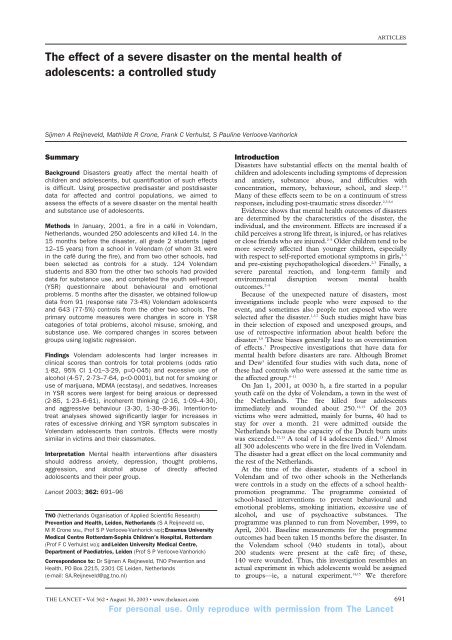
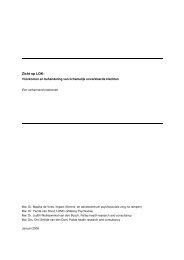
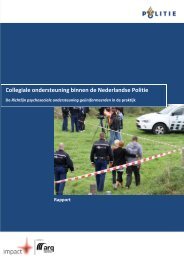
![1 [ speech 30th June, Amsterdam ] Ladies and gentlemen ... - Impact](https://img.yumpu.com/22637364/1/184x260/1-speech-30th-june-amsterdam-ladies-and-gentlemen-impact.jpg?quality=85)
